A proliferation of plant patents, trademarks, and brands in recent years has turned plant shopping into a rather confusing experience.
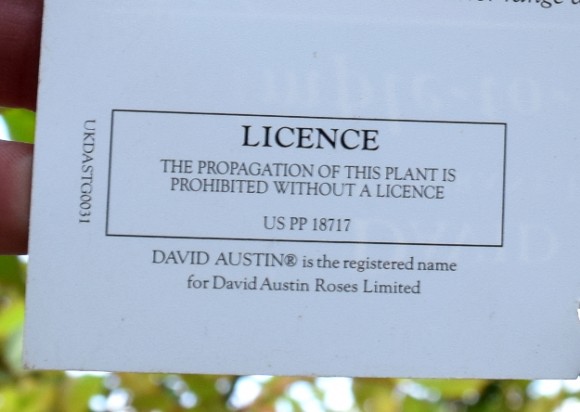
Plants now have goofy names. Have you noticed that the Knock Out rose is also called ‘Radrazz’? Or that Endless Summer hydrangea also answers to the name of ‘Bailmer’? Tags now warn menacingly, “UNLICENSED PROPAGATION PROHIBITED.” And the plain black plastic pot is being replaced by blue, pink, green, white, purple, and burgundy pots plastered with logos and brand names.

What’s happening? What are the tags really saying? And what are we allowed to propagate?
While I’m not a lawyer, I think I can answer some of these questions. If you promise not to take this post as legal advice, I’ll try to explain the situation as I understand it.
What is a plant patent?
A plant patent is legal protection that prevents anyone from propagating or selling that plant asexually without permission (which usually means buying a license) from the patent holder. It’s good for 20 years from the date of the patent application.
So it’s illegal for me to propagate any patented plant without a license?
Yes, it is—asexually, which means propagation by cuttings, grafting, divisions, layering, or tissue culture. You MAY sow seeds from a patented plant, however.
I can’t even buy a patented plant and take cuttings or make divisions for my own use—not to sell?
Nope, sorry. The one exception is that if the plant throws a “sport,” or a mutated branch (like new variegation), you may propagate it asexually. You can even patent your new plant!
How do I know if a plant is patented?
A plant you buy will have a tag that says “PP” for “Plant Patent” and then a patent number, or it will say “PPAF” for “Plant Patent Applied For.” You can also do an online search for patents. I like to use Free Patents Online, but sometimes it’s easier just to do a Google search for the plant.

So this is a new thing?
Hardly. The Plant Patent Act was passed in 1930. There have been well over 25,000 plant patents issued since then.
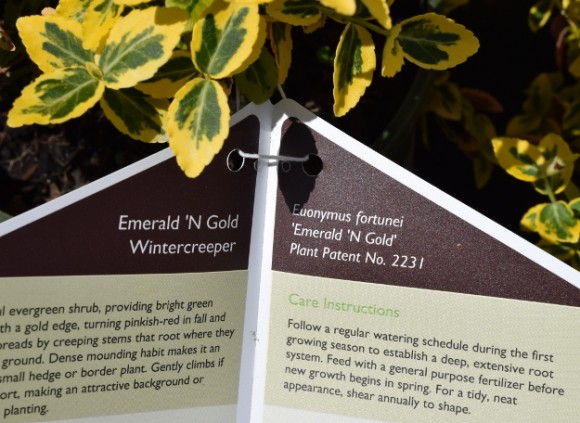
Can any plant be patented?
It has to be a cultivar (“cultivated variety”) that hasn’t been made available to the trade for more than one year. And it has to have been found in a cultivated area (a garden or nursery for example)—not in the wild.
What does it cost to patent a plant?
PlantHaven, an independent company that helps breeders get new plants to market, suggests that total costs are in the range of $2,750 to $4,000.
So what is a trademarked plant?
Ok, here’s where it gets loopy. The plant itself isn’t trademarked; its name is trademarked. What that means is that no one can sell the plant by that trademarked name without paying royalties to the owner of the trademark. A trademark lasts ten years, but can be renewed indefinitely, so it can last essentially forever.
The hitch is that the “official” name (the name you put on a patent application) can’t be a trademarked name. The plant’s official name must be one that’s freely available for anyone to use, and trademarks aren’t freely available—they’re intellectual property.
So to be able to still collect royalties on the name after the patent has expired, many patent holders make use of a tricky work-around.
Remember that anybody can freely propagate a patented plant after 20 years, but no one can sell it by the trademarked name without paying royalties. Well, the patent holder just gives the plant a “nonsense” name (like ‘Radrazz’ or ‘Bailmer’) on the patent application and then markets it under the trademarked name (Knock Out, Endless Summer). When the patent’s up, a nursery owner who wants to grow it no longer has to pay for propagating rights, but he can’t sell the plant by the name everyone recognizes without paying the trademark royalty.
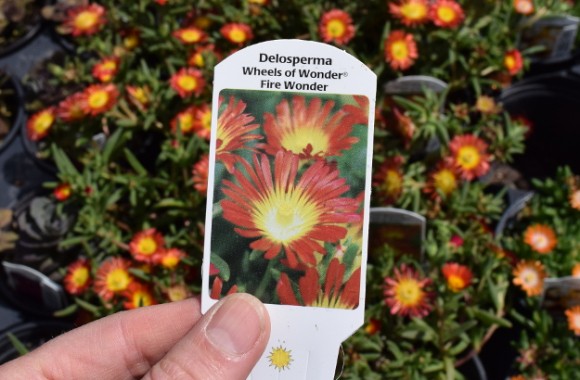
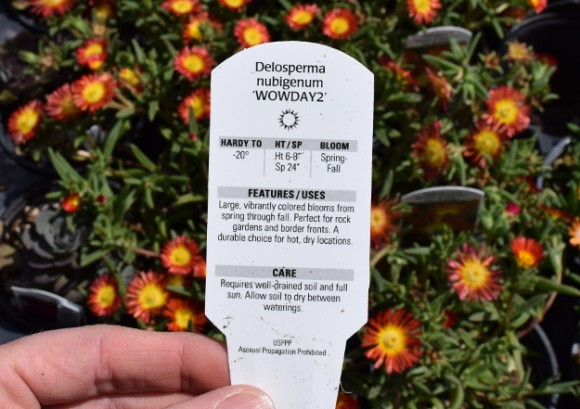
I’m simplifying a bit. For more details, there’s a wonderful, informative, and spirited rant by Dennis Carey and Tony Avent that is highly recommended reading.
What’s the difference between “™” and “®”?
The symbol ™ stands for trademark and anyone can add it to a phrase, name, or logo to indicate that they’re claiming it as their own. It doesn’t carry any weight in court, though. For an official claim of trademark, you must file with the U.S. Patent and Trademark Office and pay a fee. Then you get to use the ® symbol, which means “Registered Trademark,” and no one else in that field of business can use it.
Are patented/trademarked plants the reason for so many colored pots in the garden centers these days?
Yes. Plant branding has become big business. Some patent holders now require that growers not only pay the licensing and royalty fees, but also buy the liners (small plants for up-potting) from their growers and buy their specially branded, colored containers to pot them in. This makes it hard for some small growers compete or even participate. Mike McGroarty has a candid and thoughtful rant about “The Colored Pot Debacle” from a small grower’s perspective here.
So if a plant’s sold in a specially colored, branded pot, that means it’s patented/trademarked?
Not necessarily. A brand can represent a particular plant or line of plants, or it can identify a company that grows, breeds, or promotes certain plants. Many brands belong to nurseries or other companies that include plenty of unpatented plants under their umbrella.

For example, Monrovia is a grower and breeder that pots all of their plants—whether patented by them, by others, or not patented at all—in their own branded green pots.
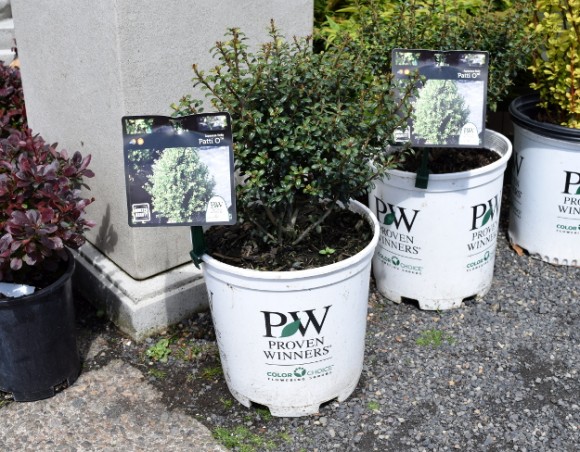
Proven Winners is a plant brand owned by a few different breeders. Their plants are sold in white pots and include mostly patented plants developed themselves or by other breeders, but there are a few plants in their line that are unpatented.
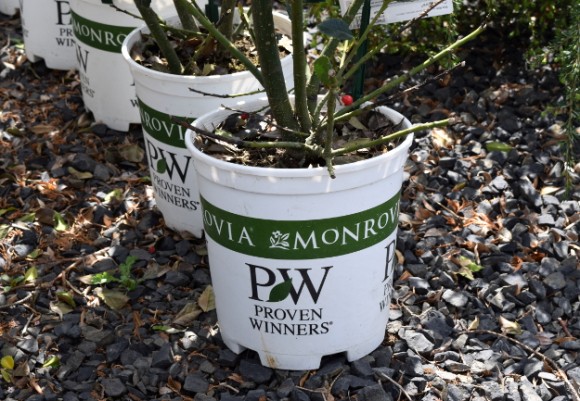
To make your head spin even more, sometimes plants are “co-branded,” as is this holly from the Proven Winners line, grown by Monrovia!
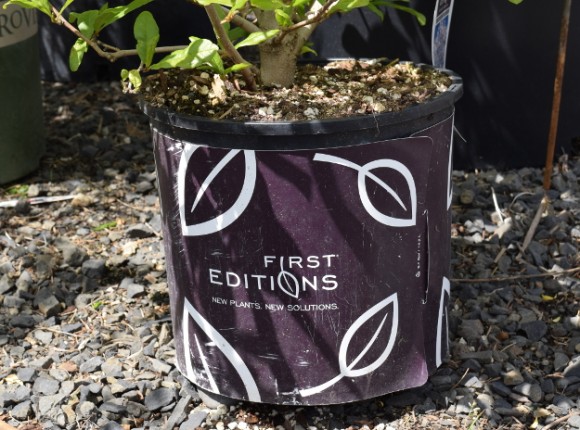
The First Editions brand, sold in purple pots, is associated with Bailey Nurseries. It includes patented plants from their own breeding, from Michael Dirr’s breeding work at Plant Introductions, Inc., and from others.
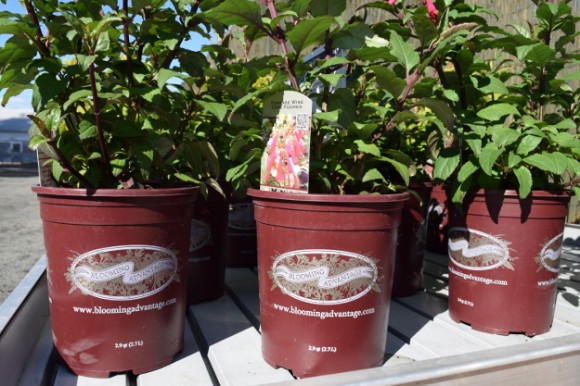
Here in the Pacific Northwest, Blooming Nursery’s Blooming Advantage plants are sold in familiar burgundy pots. Though they sell a huge variety of plants both patented and unpatented, they have no patented selections of their own.
What about seed propagated plants? Can’t they be protected, too?
Yes. As of 1970, seed-produced vegetables and annuals (and rarely, trees, shrubs, or vines) may be protected by the “PVPA,” or Plant Variety Protection Act. These seeds may not be sold without a license, but farmers and home gardeners may grow these protected seeds, save the seed, and then plant them again on their own farm or in their own garden. The USDA has more information on Plant Variety Protections here.
Haven’t I heard that Monsanto has sued farmers for saving their own seed?
Yes, but those seeds are from genetically modified crops and are protected by a third form of plant patent, the “utility patent.” Since 1980, it has been legal for companies to patent a process of producing seed. Those seeds may not be saved, and farmers sign contracts with Monsanto pledging they will not do so.
Without getting into the heated debate over whether this is right or wrong, I include it here just so you know that this issue is regulated by a different kind of patent than what you will encounter with any plant at any garden center.
I hope this post helps to clear up any confusion you may have had! I do welcome corrections or more questions in the comments.


Oh my gosh my head IS spinning. Such good information that yes, I did wonder about. Thank you for clearing it up, I’ll have to refer back to this post when my PP questions inevitably arise once again.
Tamara, I hope I haven’t made your head spin even more. It has gotten pretty complex!
So what does PBS mean on a pot? I’ve been looking all over for the answer and can’t find it…help, I want to propagate
You can do whatever you want with your own plants, you’re not going to get in trouble for propagating them and giving them away. You just shouldn’t try to sell them and you are ok. It’s really not that complicated.
Okay, so I cant find anything on my celeste fig tree from Lowes that says it is registered, trademarked or a patent number. However, the tag says “Propagation of protected plant varieties is prohibited.” Why is this on the tag if it does not apply to this plant?
It is just easier to include a blanket statement than to do the research on each plant. You can propagate your Celeste fig all you want!